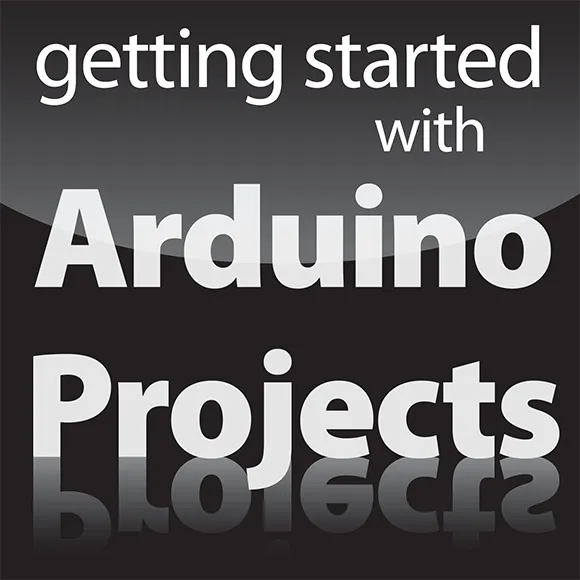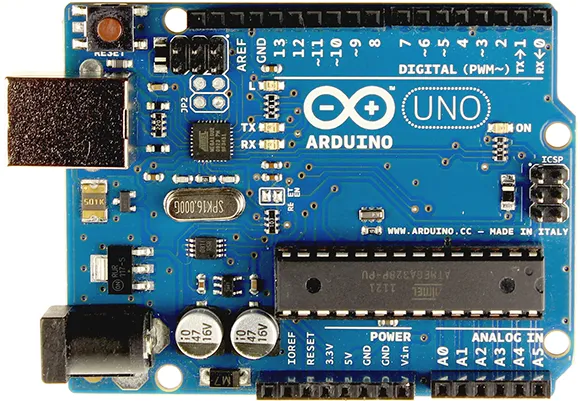Part I
Getting Started with Arduino Projects
For Dummies can help you get started with lots of subjects. Visit
www.dummies.com/extras/arduinoprojects to learn more and do more with
For Dummies.
In this part . . .
Learn how to set up your Arduino workspace
Find out about the many different kinds of Arduino boards
Get to know the basics of Arduino code
Learn about electronics components and soldering techniques
Chapter 1
Exploring the World of Arduino
In This Chapter
Understanding who uses Arduino
Understanding microcontrollers
Understanding Arduino capabilities
You probably wouldn’t have picked up this book if you hadn’t already heard about the “World of Arduino.” You’re probably already a part of it. I think of it as being made up of a community of creative people who are interested in making inanimate stuff do interesting and clever things with computers, programming, and computational thinking — which is just a fancy way of saying “writing recipes.”
Computational thinking means considering problems and their potential solutions and trying to determine the best way to get to those solutions. Usually, it means deciding the best steps to take — and in what order — as well as keeping track of important decisions along the way, or getting the right information you need to make a decision. This could be doing something simple like baking cookies, in which case you probably don’t need a computer. But you can use a little bit of computing power to carry out a simple sequence of steps and decisions to come up with something really creative.
Maybe you want to know when your cat is coming and going from your house. Perhaps you want to know when your houseplants need a little more water and then give it to them automatically. Or suppose that you want to be able to open your front door with a code or card, instead of a physical key. Each of these involves just a little bit of sensing what’s going on in the real world, combined with decision making, and then performing some kind of action.
In the case of watering your plants, it’s something a human might be prone to forgetting or something you just don’t want to pay attention to all the time. Sounds like the perfect job for a computer. That’s where Arduino comes to the rescue.
About Arduino
The Arduino Uno (see Figure 1-1) is a general purpose microcontroller programming and prototyping platform that you can easily program to react to things going on in the real world. You can also link between the real world and the virtual world by connecting up your Arduino to the Internet, either sending data to the Internet or responding to data on the Internet, or both.
You can use it to sense almost anything you can find an electronic sensor for, including light, temperature, pressure, sound, even smell — if you consider environmental pollution to be a smell. You can even build your own sensors. How your Arduino reacts depends on how you program it. You can use its output capabilities to sound alarms, open doors and windows, activate lights or motors — the possibilities are almost endless.
Arduino is used for prototyping ideas — getting them half built and then trying out what works. Prototyping means testing alternatives to come up with creative solutions to problems (see Figure 1-1). You try out part of a project to see how your sensors respond and then change how your Arduino program functions, depending on what works best for you. Although the projects in this book are like little recipes, they are just a starting point. You could — and should — use any of them to build much more elaborate ideas and projects.
Figure 1-1: The general purpose Arduino Uno prototyping board.
Discovering Who Uses Arduino
The Arduino family is used by makers, hackers, designers, artists, architects, and even professional engineers to quickly and easily try out interactive design ideas. The Arduino Uno is inexpensive and easy to use, with a big community of supporters, tinkerers, and developers who are constantly coming up with new ways to use it and improve it. In the next sections, I go over a few of the kinds of people and communities that are using Arduinos every day.
Arduino in education
Arduino provides a really simple way to learn how to program microcontrollers to sense and react to events in the real world and even online. Because it was conceived as a way to support designers and artists — people who are not typically computer programmers — it is very easy to get started and easy to use. I have taught hundreds of people — from little kids to retirees — to get started programming with Arduino. They have gotten simple programs up and running in as little as a half-hour and built their skills to develop their own sophisticated projects in a weekend. As you see from the projects in this book, it doesn’t take long to get your Arduino doing some pretty interesting stuff. And the more time you put into using it, the more you can get out of it.
Art and design schools use Arduino to design new interactive product prototypes, interactive artwork, performances, and even clothing. High schools and secondary schools teach core concepts in computer programming. University students in engineering and computer science departments use Arduino to create interactive models and prototypes as well as learn sophisticated computer-controlled engineering techniques.
Arduino in the corporate world
A growing community of industry professionals in the corporate world use Arduinos to make interactive stuff in their work. Design firms use them to develop interactive product prototypes. Software engineering companies use them to test software systems that interact with the physical world. Ad agencies use them to come up with new and creative interactive campaigns. Arduinos are used to control interactive exhibits and conferences and trade shows in both the industry and in digital media sectors. They are used as management-consulting tools to help teams coordinate problem solving and improve collaboration.
Making and hacking communities
In little pockets all over the world, a new community of tinkerers, makers, and hackers has emerged. Arduino has been a fuel for this creative fire and continues to be one of the key hardware prototyping platforms that people create projects with, talk about, and share with one another.
What are they about?
There have been small electronics and hardware clubs since the early days of the twentieth century, when teenage boys were encouraged to build their own “cat’s whisker” radios to listen to the new local radio stations that were popping up all across the United States. Over the decades, a large community of radio buffs grew, especially among fans of the shortwave radio frequencies. These “ham” radio aficionados set up their own transmitters and spent long hours listening to the radio waves for new and far-flung transmissions from friends and strangers. By the 1970s, the stage was set for a whole ...















